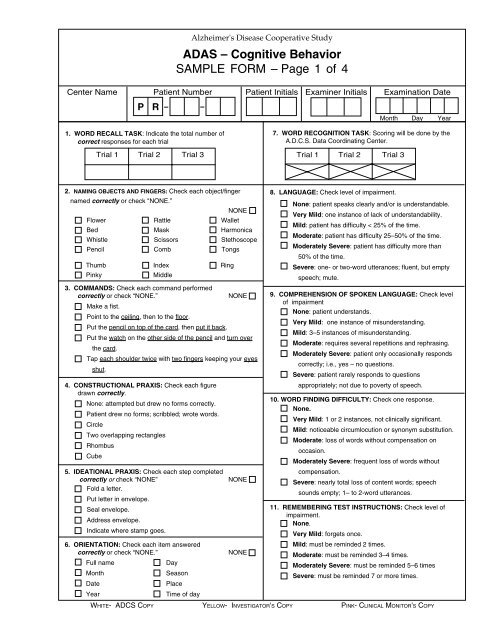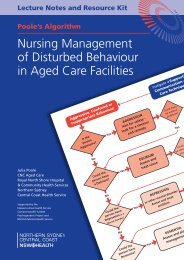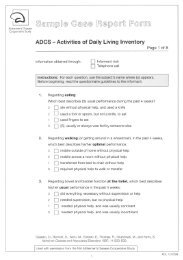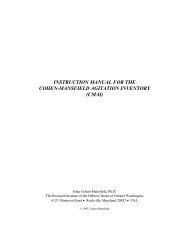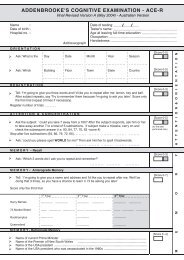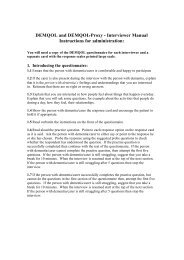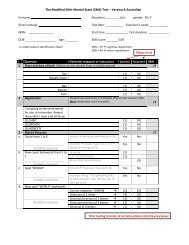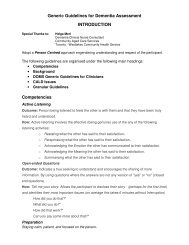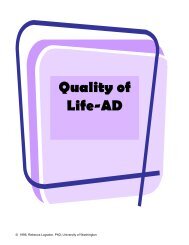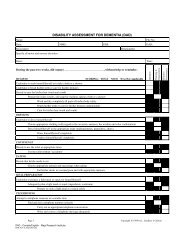ADAS â Cognitive Behavior SAMPLE FORM â Page 1 of 4
ADAS â Cognitive Behavior SAMPLE FORM â Page 1 of 4
ADAS â Cognitive Behavior SAMPLE FORM â Page 1 of 4
Create successful ePaper yourself
Turn your PDF publications into a flip-book with our unique Google optimized e-Paper software.
Center Name Patient Number Patient Initials Examiner Initials Examination Date<br />
P R<br />
1. WORD RECALL TASK: Indicate the total number <strong>of</strong><br />
correct responses for each trial<br />
2. NAMING OBJECTS AND FINGERS: Check each object/finger<br />
named correctly or check "NONE.”<br />
NONE<br />
Flower Rattle Wallet<br />
Bed Mask Harmonica<br />
Whistle Scissors Stethoscope<br />
Pencil Comb Tongs<br />
Make a fist.<br />
Point to the ceilinq, then to the floor.<br />
Put the pencil on top <strong>of</strong> the card, then put it back.<br />
Put the watch on the other side <strong>of</strong> the pencil and turn over<br />
the card.<br />
Tap each shoulder twice with two fingers keeping your eyes<br />
shut.<br />
None: attempted but drew no forms correctly.<br />
Patient drew no forms; scribbled; wrote words.<br />
Circle<br />
Two overlapping rectangles<br />
Rhombus<br />
Cube<br />
5. IDEATlONAL PRAXIS: Check each step completed<br />
correctly or check “NONE” NONE<br />
Fold a letter.<br />
Put letter in envelope.<br />
Seal envelope.<br />
Address envelope.<br />
Indicate where stamp goes.<br />
Full name Day<br />
Month Season<br />
Date Place<br />
Year Time <strong>of</strong> day<br />
Month Day Year<br />
7. WORD RECOGNITION TASK: Scoring will be done by the<br />
A.D.C.S. Data Coordinating Center.<br />
Trial 1 Trial 2 Trial 3 Trial 1 Trial 2 Trial 3<br />
Thumb Index Ring<br />
Pinky Middle<br />
3. COMMANDS: Check each command performed<br />
correctly or check “NONE.” NONE<br />
4. CONSTRUCTIONAL PRAXIS: Check each figure<br />
drawn correctly.<br />
6. ORIENTATION: Check each item answered<br />
correctly or check “NONE.” NONE<br />
Alzheimer's Disease Cooperative Study<br />
<strong>ADAS</strong> – <strong>Cognitive</strong> <strong>Behavior</strong><br />
<strong>SAMPLE</strong> <strong>FORM</strong> – <strong>Page</strong> 1 <strong>of</strong> 4<br />
8. LANGUAGE: Check level <strong>of</strong> impairment.<br />
None: patient speaks clearly and/or is understandable.<br />
Very Mild: one instance <strong>of</strong> lack <strong>of</strong> understandability.<br />
Mild: patient has difficulty < 25% <strong>of</strong> the time.<br />
Moderate: patient has difficulty 25–50% <strong>of</strong> the time.<br />
Moderately Severe: patient has difficulty more than<br />
50% <strong>of</strong> the time.<br />
Severe: one- or two-word utterances; fluent, but empty<br />
speech; mute.<br />
9. COMPREHENSION OF SPOKEN LANGUAGE: Check level<br />
<strong>of</strong> impairment<br />
None: patient understands.<br />
Very Mild: one instance <strong>of</strong> misunderstanding.<br />
Mild: 3–5 instances <strong>of</strong> misunderstanding.<br />
Moderate: requires several repetitions and rephrasing.<br />
Moderately Severe: patient only occasionally responds<br />
correctly; i.e., yes – no questions.<br />
Severe: patient rarely responds to questions<br />
appropriately; not due to poverty <strong>of</strong> speech.<br />
10. WORD FINDING DIFFICULTY: Check one response.<br />
None.<br />
Very Mild: 1 or 2 instances, not clinically significant.<br />
Mild: noticeable circumlocution or synonym substitution.<br />
Moderate: loss <strong>of</strong> words without compensation on<br />
occasion.<br />
Moderately Severe: frequent loss <strong>of</strong> words without<br />
compensation.<br />
Severe: nearly total loss <strong>of</strong> content words; speech<br />
sounds empty; 1– to 2-word utterances.<br />
11. REMEMBERING TEST INSTRUCTIONS: Check level <strong>of</strong><br />
impairment.<br />
None.<br />
Very Mild: forgets once.<br />
Mild: must be reminded 2 times.<br />
Moderate: must be reminded 3–4 times.<br />
Moderately Severe: must be reminded 5–6 times<br />
Severe: must be reminded 7 or more times.<br />
WHITE- ADCS COPY YELLOW- INVESTIGATOR'S COPY PINK- CLINICAL MONITOR'S COPY
Center Name Patient Number Patient Initials Examiner Initials Examination Date<br />
P R<br />
Present Word List #2.<br />
Check EACH word correctly recalled.<br />
BOTTLE<br />
POTATO<br />
GIRL<br />
TEMPLE<br />
STAR<br />
ANIMAL<br />
FOREST<br />
LAKE<br />
CLOCK<br />
OFFICE<br />
TRIAL 1<br />
FOREST<br />
TEMPLE<br />
BOTTLE<br />
STAR<br />
POTATO<br />
GIRL<br />
CLOCK<br />
ANIMAL<br />
LAKE<br />
OFFICE<br />
TRIAL 2<br />
GIRL<br />
TEMPLE<br />
POTATO<br />
ANIMAL<br />
FOREST<br />
LAKE<br />
OFFICE<br />
CLOCK<br />
BOTTLE<br />
STAR<br />
TOTAL TOTAL TOTAL<br />
Month Day Year<br />
TRIAL 3<br />
Indicate total number <strong>of</strong> words correctly recalled for EACH trial on the <strong>ADAS</strong> <strong>Cognitive</strong> <strong>Behavior</strong> Form.<br />
12. Executive Function (Maze):<br />
a. number <strong>of</strong> errors<br />
b. time at completion or second error<br />
(total seconds)<br />
13. Number Cancellation:<br />
a. number <strong>of</strong> targets hit<br />
(Range: 0 - 40)<br />
b. number <strong>of</strong> errors<br />
c. number <strong>of</strong> times to remind <strong>of</strong> task<br />
Alzheimer's Disease Cooperative Study<br />
<strong>ADAS</strong> – Word Recall<br />
<strong>SAMPLE</strong> <strong>FORM</strong> – <strong>Page</strong> 2 <strong>of</strong> 4<br />
If any item(s) 1-13 are incomplete or not<br />
done, please specify reason:<br />
Subject too cognitively impaired to<br />
complete<br />
Subject was unable to complete for<br />
physical reasons<br />
Subject refused<br />
Not Done, for reason other than<br />
above explain: ________________<br />
___________________________<br />
___________________________<br />
___________________________<br />
___________________________<br />
___________________________<br />
WHITE- ADCS COPY YELLOW- INVESTIGATOR'S COPY PINK- CLINICAL MONITOR'S COPY
Center Name Patient Number Patient Initials Examiner Initials Examination Date<br />
P R<br />
BOTTLE<br />
POTATO<br />
GIRL<br />
TEMPLE<br />
STAR<br />
ANIMAL<br />
FOREST<br />
LAKE<br />
CLOCK<br />
OFFICE<br />
Month Day Year<br />
Instructions: Say to the patient, “NOW I WANT YOU TO TRY TO REMEMBER THE<br />
WORDS THAT I SHOWED YOU EARLIER ON PRINTED CARDS. CAN YOU TELL ME<br />
ANY OF THOSE WORDS?”<br />
Allow a maximum <strong>of</strong> two minutes for recall.<br />
Alzheimer's Disease Cooperative Study<br />
<strong>ADAS</strong> – Delayed Recall<br />
<strong>SAMPLE</strong> <strong>FORM</strong> – <strong>Page</strong> 3 <strong>of</strong> 4<br />
check EACH word correctly recalled.<br />
TOTAL<br />
WHITE- ADCS COPY YELLOW- INVESTIGATOR'S COPY PINK- CLINICAL MONITOR'S COPY
Center Name Patient Number Patient Initials Examiner Initials Examination Date<br />
P R<br />
Month Day Year<br />
Present Word List #2.<br />
COST<br />
NATION<br />
CHIMNEY<br />
SPARROW<br />
DAMAGES<br />
TRAFFIC<br />
SANDWICH<br />
SERVICE<br />
SHELL<br />
SOLUTION<br />
YARD<br />
TUBE<br />
BODY<br />
GROUND<br />
STICK<br />
ENGINE<br />
RICHES<br />
GRAVITY<br />
SUMMER<br />
WISDOM<br />
MAN<br />
MEAL<br />
PASSENGER<br />
ACID<br />
*see procedures manual for further clarification<br />
Alzheimer's Disease Cooperative Study<br />
<strong>ADAS</strong> – Word Recognition<br />
<strong>SAMPLE</strong> <strong>FORM</strong> – <strong>Page</strong> 4 <strong>of</strong> 4<br />
Check subject's response for each word. Subject should respond "yes" to original words<br />
which are bolded. INCORRECT responses are shaded. Three trials <strong>of</strong> reading and<br />
recognition are given.<br />
Yes No Yes No Yes No<br />
BATTLE<br />
MUCH<br />
TUBE<br />
TEAM<br />
COPY<br />
ENGINE<br />
GRAVITY<br />
COST<br />
JAR<br />
DISTANCE<br />
TRIUMPH<br />
TEMPER<br />
SENTENCE<br />
FOX<br />
PASSENGER<br />
SANDWICH<br />
SOLUTION<br />
WHISTLE<br />
CHIMNEY<br />
UNION<br />
ACID<br />
MEAL<br />
DAMAGES<br />
RICHES<br />
VISITOR<br />
ACID<br />
SPEAK<br />
SOLUTION<br />
NAME<br />
MEAL<br />
LINE<br />
BILL<br />
CHIMNEY<br />
ENGINE<br />
WEALTH<br />
TUBE<br />
IMAGE<br />
COST<br />
SANDWICH<br />
DAMAGES<br />
ELEPHANT<br />
RICHES<br />
GRAVITY<br />
FUTURE<br />
PASSENGER<br />
STRING<br />
BANNER<br />
BERRY<br />
WHITE- ADCS COPY YELLOW- INVESTIGATOR'S COPY PINK- CLINICAL MONITOR'S COPY
Example
"6" and "1"<br />
1 2 2 4 5 9 5 6 6 9 1 9 6 7 8 3 2 4 3 7 2 1 4 2 2 1 2 6 6 3<br />
Example for use with versions A, B, and C
"2" and "8"<br />
6 2 6 7 2 3 1 3 8 5 5 5 8 1 7 9 1 7 2 7 4 5 7 6 1 3 9 6 2 1<br />
9 4 6 9 5 7 1 8 9 5 6 5 4 2 7 1 5 2 7 9 1 7 1 1 1 4 2 8 5 8<br />
1 9 7 9 7 1 6 7 8 6 5 5 7 2 9 6 5 9 5 4 7 3 2 4 5 6 1 4 3 4<br />
4 6 8 4 1 4 1 7 2 4 7 1 7 6 7 5 4 9 8 7 5 6 2 1 6 9 3 1 4 8<br />
7 8 6 7 1 7 1 3 4 3 9 8 6 5 1 8 3 4 2 6 9 9 6 1 6 4 3 9 3 4<br />
4 9 3 8 7 2 5 4 4 8 7 6 4 1 4 7 2 6 8 7 5 6 3 2 6 4 4 6 8 4<br />
4 8 3 4 7 5 4 4 7 9 7 3 6 8 6 5 4 7 4 3 4 9 2 5 3 5 4 7 3 5<br />
4 9 3 3 8 1 8 4 2 6 5 6 6 1 7 2 4 2 9 7 9 7 6 1 5 1 4 1 9 8<br />
A
<strong>ADAS</strong><br />
Administration Manual<br />
for the<br />
Alzheimer’s Disease Assessment Scale<br />
Adapted from the Administration and Scoring Manual for the<br />
Alzheimer’s Disease Assessment Scale,<br />
1994 Revised Edition, Richard C. Mohs, Ph.D.<br />
Copyright © 1994 by<br />
The Mount Sinai School <strong>of</strong> Medicine<br />
Present manual modified by:<br />
Donald Connor, Ph.D<br />
Kimberly Schafer, MS<br />
(3/98)<br />
A Publication <strong>of</strong> the<br />
Alzheimer’s Disease Cooperative Study
<strong>ADAS</strong><br />
INTR INTRODUCTION<br />
INTR INTR ODUCTION<br />
The test items on the cognitive part <strong>of</strong> the <strong>ADAS</strong> should be given in the order indicated.<br />
The WORD RECALL test is given first<br />
and the<br />
WORD RECOGNITION task is given last<br />
with the<br />
other cognitive tests given in-between.<br />
Separating the two word memory tasks in this way minimizes the chance that a subject will confuse<br />
the words from the two tasks.<br />
At the start <strong>of</strong> a test session, before giving the WORD RECALL test, the tester should have a short<br />
conversation with the subject about neutral topics such as the weather, the subject’s trip to the<br />
clinic, or what the subject had for breakfast. This conversation will help to put the subject at ease<br />
before the testing begins and will give the tester an opportunity to observe how the subject can use<br />
and understand language.<br />
There are three clinical ratings <strong>of</strong> language ability on the cognitive part <strong>of</strong> the <strong>ADAS</strong>.<br />
The <strong>ADAS</strong> is not a timed test and the subject’s score does not depend upon how rapidly the test is<br />
completed. The cognitive items should be given so that the session moves smoothly and quickly, but<br />
not so that the subject feels pressured to respond rapidly.<br />
Feedback to the subject should be neutral and, usually, should not indicate whether or not the<br />
response was correct. Comments such as, “That’s fine” or “You’re doing well” are appropriate<br />
as long as the subject is trying. If the subject specifically asks whether or not they were correct,<br />
feedback can be given.<br />
TABLE OF CONTENTS PAGE<br />
Word Recall Task.................................................................... 2<br />
Naming Task ......................................................................... 3 - 4<br />
Commands .............................................................................. 5<br />
Constructional Praxis ........................................................ 6 - 7<br />
Ideational Praxis ..................................................................... 8<br />
Orientation ............................................................................. 9<br />
Word Recognition ............................................................ 10 - 11<br />
Remembering Test Instructions.......................................... 12<br />
Spoken Language Ability ...................................................... 13<br />
Word–Finding Difficulty and Comprehension ................ 14<br />
1
<strong>ADAS</strong><br />
INS INSTR INS TR TRUCTIONS TRUCTIONS<br />
UCTIONS f ffor<br />
f or W WWORD<br />
W ORD REC RECALL REC ALL T TTASK<br />
T TASK<br />
ASK<br />
On this task, the subject is given three trials to learn a list <strong>of</strong> high-frequency, highimagery<br />
nouns. The 10 words are printed in block letters on white cards.<br />
Use the appropriate word list for each visit as indicated on the study worksheet, and record the<br />
subject’s responses on the study worksheet.<br />
At the start <strong>of</strong> the first trial,<br />
the tester gives instructions<br />
similar to the following:<br />
The examiner can prompt with:<br />
After the presentation, the<br />
tester asks the subject to try<br />
to recall as many <strong>of</strong> the<br />
words as possible by saying:<br />
For trials 2 and 3, say to the<br />
subject:<br />
“I am going to show you some words printed on these<br />
white cards one at a time. Please read each word out loud<br />
and try to remember it, because later I will ask you to try<br />
to remember all <strong>of</strong> the words I have shown you. Ready,<br />
read the word and try to remember it.”<br />
“Read it out loud and try to remember it” as necessary.<br />
If the subject cannot read the word or is slow, the examiner can say the word out loud and have the<br />
subject repeat it. Note this and continue with this procedure at each testing. In some cases, the<br />
examiner may have to say all <strong>of</strong> the words and have the subject repeat them. Regardless, make sure<br />
the subject looks at each word while repeating it.<br />
Two more learning and recall trials follow.<br />
“Good, now tell me all the words you remember that were<br />
on the list.”<br />
“Now I’m going to show you that same list again. Read<br />
each word out loud and try to remember it.”<br />
Encouragement can be given if the subject is nervous or giving up.<br />
SCORING:<br />
The subject’s score is the mean number <strong>of</strong> words not<br />
recalled on three trials (maximum score = 10)<br />
Enter the subject’s score on the study worksheet<br />
2
<strong>ADAS</strong><br />
INS INSTR INS INSTR<br />
TR TRUCTIONS TRUCTIONS<br />
UCTIONS f ffor<br />
f or N NNAMIN<br />
N AMIN AMING AMIN G T TTASK<br />
T ASK<br />
For this task, the subject is asked to name the 12 randomly presented real objects, with<br />
high (Flower, Bed, Whistle, Pencil),<br />
medium (Rattle, Mask, Scissors, Comb), and<br />
low (Wallet, Harmonica, Stethoscope, Tongs) frequency values.<br />
The subject is also asked to name the fingers on his/her dominant hand.<br />
Use the study worksheet to record the subject’s responses.<br />
Objects should be presented in random order. Do not allow the subject to touch the objects.<br />
Give the subject instructions<br />
similar to the following:<br />
Continue to present objects<br />
in random order. The first<br />
question about each object<br />
should be:<br />
If the subject responds with<br />
the object’s function say:<br />
“Now I am going to show you some objects. I want you to<br />
tell me what their names are. What is this called?”<br />
(present object)<br />
“What is this called?” or “ What is the name <strong>of</strong> this thing?”<br />
“Yes, that’s what it does, but what is its name?”<br />
If the subject does not respond, the examiner should give the clue for that item provided<br />
below. If the subject still does not respond or makes an error, go on to the next object.<br />
ITEM CLUES<br />
Flower grows in a garden<br />
Bed used for sleeping in<br />
Whistle makes a sound when you blow on it<br />
Pencil used for writing<br />
Rattle a baby’s toy<br />
Mask hides your face<br />
Scissors cuts paper<br />
Comb used on hair<br />
Wallet holds your money<br />
Harmonica a musical instrument<br />
Stethoscope doctor uses it to listen to your heart<br />
Tongs picks up food<br />
3
<strong>ADAS</strong><br />
INS INSTR INS TR TRUCTIONS TR UCTIONS f ffor<br />
f or N NNAMIN<br />
N AMIN AMING AMIN G T TTASK<br />
TT<br />
ASK (Cont (Cont’d.) (Cont d.) d.)<br />
The subject is also asked to name the fingers <strong>of</strong> his/her dominant hand (e.g., thumb, index<br />
[pointer/forefinger], middle, ring finger, and pinky).<br />
Give the subject instructions<br />
similar to the following:<br />
For the 4 fingers, if a query is<br />
necessary, say:<br />
“Now I am going to point to a part <strong>of</strong> your hand and I want<br />
you to tell me what it’s called. What is this?”<br />
“What is another name for this finger?”<br />
ITEM<br />
Thumb<br />
Index/forefinger/pointer<br />
Middle<br />
Ring<br />
Pinky<br />
The hardest part <strong>of</strong> scoring the naming task is determination <strong>of</strong> the range <strong>of</strong> correct responses<br />
based on the subject’s cultural and geographical background. A response other than the name given<br />
on the response form should be scored as correct if it is a name that would be used by a nondemented<br />
person with the same cultural background as the subject.<br />
FOR EXAMPLE: the Mask might be called a “false face” in some parts <strong>of</strong> the U.S.; the Wallet<br />
might be called a “billfold” or the Harmonica might be called a “mouth organ”.<br />
Descriptions <strong>of</strong> the object, semantic or phonemic paraphasias should not be scored as correct.<br />
EXAMPLES OF INCORRECT RESPONSES ARE: “listening thing” for Stethoscope,<br />
“cutter” for Scissors, and<br />
“prongs” for Tongs.<br />
SCORING<br />
0 = 0-2 items (objects and fingers) named incorrectly<br />
1 = 3-5 items (objects and fingers) named incorrectly<br />
2 = 6-8 items (objects and fingers) named incorrectly<br />
3 = 9-11 items (objects and fingers) named incorrectly<br />
4 = 12-14 items (objects and fingers) named incorrectly<br />
5 = 15-17 items (objects and fingers) named incorrectly<br />
Enter the subject’s score on the study worksheet.<br />
4
<strong>ADAS</strong><br />
INS INSTR INS TR TRUCTIONS TR UCTIONS ff<br />
for ff<br />
or CC<br />
COMMANDS<br />
C OMMANDS<br />
This task is designed to assess receptive speech. The subject is asked to carry out<br />
5 separate commands with 1 to 5 steps per command.<br />
Each command should be read once. If the<br />
subject does not respond or makes an<br />
error, the tester should give the ENTIRE<br />
command one more time.<br />
All commands should be given to every<br />
subject.<br />
If the subject demonstrates hearing or<br />
attentional difficulties, orient them by<br />
saying, “Ready?” or “Now I want you<br />
to...” prior to giving the command. Do<br />
NOT give the command more than twice.<br />
5<br />
There should be no other materials near the<br />
pencil, watch and card (pens, paper, etc.)<br />
Each underlined element represents a single<br />
step.<br />
Each command is scored as a whole (no<br />
partial credit). All components must be<br />
correct for the response to be scored as<br />
correct.<br />
Use the study worksheet to record the<br />
subject’s responses.<br />
Give the subject instructions<br />
similar to the following: “Now I am going to ask you to do a few things. First, ...<br />
“Make a FIST.” (“Relax it” if needed)<br />
“Point to the CEILING and then to the FLOOR.”<br />
Line up a Pencil, Watch, and<br />
Card on the table. Say: “Put the PENCIL ON TOP OF THE CARD and then<br />
PUT IT BACK.”<br />
“Put the WATCH on the OTHER SIDE OF THE PENCIL<br />
and then TURN OVER THE CARD.”<br />
Remove the Pencil, Watch,<br />
and Card from the table. Say: “TAP EACH SHOULDER TWICE with TWO FINGERS<br />
keeping your EYES SHUT.”<br />
SCORING<br />
0 = All commands correct<br />
1 = 1 command incorrect, 4 commands correct<br />
2 = 2 commands incorrect, 3 commands correct<br />
3 = 3 commands incorrect, 2 commnads correct<br />
4 = 4 commands incorrect, 1 command correct<br />
5 = All 5 commands correct<br />
Enter the subject’s score on the study worksheet
<strong>ADAS</strong><br />
INS INSTR INS TR TRUCTIONS TR UCTIONS f ffor<br />
f or C CCONS<br />
C CONS<br />
ONS ONSTR ONS TR TRUCTION TR UCTION UCTIONAL UCTION AL PRAXIS<br />
PRAXIS<br />
This test assesses the subject’s ability to copy 4 geometric forms ranging from a very<br />
simple one (circle) to a fairly difficult one (cube).<br />
Use the study worksheet to score the subject’s responses.<br />
The forms provided should be presented one at a time.<br />
The tester should give the subject a lead pencil with an<br />
eraser along with the drawing.<br />
The instructions to the subject<br />
should be similar to the<br />
following: “On this piece <strong>of</strong> paper is a shape. Try to draw another one<br />
that looks just like this, somewhere on the page.”<br />
(Examiner may point to shape)<br />
If the subject’s response is<br />
quick or sloppy, prompt with: “Take your time and try to draw it just like this one.”<br />
The subject should be allowed two attempts for each<br />
shape. Allow a second attempt only if the subject asks or<br />
indicates a problem with their drawing. The subject may<br />
erase if they need to. If the subject draws on top <strong>of</strong> the<br />
printed design, count this as one attempt and indicate that<br />
they should try on an empty part <strong>of</strong> the page. If the<br />
subjects says the reproduction is poor, query if the<br />
subject wants another try. When two attempts are made,<br />
ask the subject to indicate which one is the best, and then<br />
score that attempt.<br />
If the subject cannot reproduce the figure in two attempts,<br />
the tester should go on to the next item.<br />
A drawing should be scored as correct if the subject has<br />
reproduced all <strong>of</strong> the essential features <strong>of</strong> the original.<br />
Changes in size do not count as errors. Small gaps<br />
between lines do not indicate an error, as long as the<br />
shape has been reproduced.<br />
6
<strong>ADAS</strong><br />
INS INSTR INS TR TRUCTIONS TRUCTIONS<br />
UCTIONS f ffor<br />
f or C CCONS<br />
C ONS ONSTR ONS TR TRUCTION TR UCTION UCTIONAL UCTION AL PRAXIS PRAXIS (cont (cont’d) (cont d)<br />
The forms should be presented in the following<br />
order:<br />
Circle<br />
Two Overlapping Rectangles<br />
Diamond (Rhombus)<br />
Cube<br />
SCORING GUIDELINES:<br />
Circle: A closed curved figure<br />
Two Overlapping Rectangles: Forms<br />
must be four-sided, and overlap must be<br />
similar to presented form. Changes in<br />
size are not scored.<br />
Diamond (Rhombus): Figure must be foursided,<br />
oriented so that the points are at the<br />
top and bottom, and the sides are<br />
approximately equal length (e.g., longest<br />
side is not > 1.5 times the length <strong>of</strong> the<br />
shortest side).<br />
Cube: The form is 3-dimensional, with<br />
front face in the correct orientation,<br />
internal lines drawn correctly<br />
between corners. Opposite sides <strong>of</strong><br />
faces should be approximately parallel.<br />
SCORING<br />
0 = All 4 drawings correct<br />
1 = 1 form drawn incorrectly<br />
2 = 2 forms drawn incorrectly<br />
3 = 3 forms drawn incorrectly<br />
4 = 4 forms drawn incorrectly<br />
5 = No figures drawn, scribbles; parts <strong>of</strong><br />
forms; words instead <strong>of</strong> forms<br />
Enter the subject’s score on the study<br />
worksheet<br />
7<br />
Examples <strong>of</strong> Correct and Incorrect Drawings:<br />
Overlapping Rectangles<br />
Diamond<br />
Cube<br />
Correct<br />
Incorrect<br />
Correct Incorrect<br />
Correct Incorrect
<strong>ADAS</strong><br />
INS INSTR INS TR TRUCTIONS TR UCTIONS f ffor<br />
f or IDEA IDEATION IDEA TION TIONAL TION AL PRAXIS<br />
PRAXIS<br />
This task is designed to determine whether the subject can perform a familiar but complex<br />
sequence sequence <strong>of</strong> actions.<br />
Use the study worksheet to record the<br />
subject’s responses.<br />
There are 5 components to this task and<br />
each one is underlined in the instruction.<br />
If the subject forgets part <strong>of</strong> the task, or is<br />
having difficulty, the tester should repeat the<br />
instruction for the component <strong>of</strong> the task<br />
where the subject is having difficulty.<br />
FOR EXAMPLE: If the subject stops after<br />
folding the paper and putting it in the<br />
envelope, the tester should give one<br />
reminder on the next component:, “Now<br />
seal the envelope.” If the subject cannot<br />
do this part, move on and give one<br />
reminder on the next component:“Now<br />
address the envelope to yourself.”<br />
SCORING<br />
0 = All components performed correctly<br />
1 = Failure to perform 1 component<br />
2 = Failure to perform 2 components<br />
3 = Failure to perform 3 components<br />
4 = Failure to perform 4 components<br />
5 = Failure to perform 5 components<br />
Enter the subject’s score on the study worksheet<br />
8<br />
A long envelope, an 8.5” x 11” sheet <strong>of</strong><br />
paper and a pencil are placed in front <strong>of</strong><br />
the subject.<br />
Give the subject instructions<br />
similar to the following: “I want you to pretend you have written yourself a letter.<br />
Take this piece <strong>of</strong> paper, fold it so that it will fit into the<br />
envelope, and then put it into the envelope. Then, seal the<br />
envelope, address the envelope to yourself, and show me<br />
where the stamp goes.”<br />
After the first complete instruction only one<br />
additional reminder should be given for<br />
each component.<br />
Impairment on this item should reflect<br />
dysfunction in executing an overlearned<br />
task only and not recall difficulty.<br />
Any address which would enable a postal<br />
worker to deliver the envelope is counted<br />
as correct, even though it might not<br />
contain the subject’s current address. The<br />
address should contain: name, street, city,<br />
and state. Zip code is not required.<br />
Have the subject indicate where the stamp<br />
goes by placing an “X” on the envelope.
<strong>ADAS</strong><br />
INS INSTR INS TR TRUCTIONS TRUCTIONS<br />
UCTIONS f ffor<br />
f or ORIENT ORIENTATION<br />
ORIENT TION<br />
This task is designed to determine how well oriented the subject is with regard to time<br />
and place.<br />
Use the study worksheet to record the<br />
subject’s responses.<br />
The components <strong>of</strong> orientation are:<br />
Person<br />
Day <strong>of</strong> the Week<br />
Date, Month, Year<br />
Season<br />
Time <strong>of</strong> Day<br />
Place<br />
The tester should ask the subject for each <strong>of</strong><br />
these pieces <strong>of</strong> information one at a time.<br />
Make sure no watches, clocks, calendars, etc.<br />
are visible to the subject.<br />
One restatement <strong>of</strong> question is allowed<br />
(e.g.,if subject confuses day and date).<br />
9<br />
Acceptable range for answers include:<br />
Date: + one day<br />
Time: + one hour<br />
Place: Partial name acceptable (e.g., name<br />
<strong>of</strong> hospital, clinic or pr<strong>of</strong>essional<br />
building)<br />
Season: Within one week prior to onset or<br />
within two weeks <strong>of</strong> termination<br />
Month, Year, Day <strong>of</strong> the Week, and the<br />
subject’s first and last name must be<br />
exact.<br />
SCORING: One point is given for each incorrect<br />
response (maximum = 8)<br />
Enter the subject’s score on the study<br />
worksheet.
<strong>ADAS</strong><br />
INS INSTR INS INSTR<br />
TR TRUCTIONS TRUCTIONS<br />
UCTIONS f ffor<br />
f for<br />
or WW<br />
WORD W ORD REC RECOGNITION<br />
REC REC OGNITION<br />
On this task the subject is given one trial to learn a list <strong>of</strong> 12 words.<br />
Use the appropriate word list as indicated<br />
on the study worksheet, and record the<br />
subject’s responses on the study worksheet.<br />
The learning part <strong>of</strong> this trial is similar to<br />
the learning part <strong>of</strong> the WORD RECALL<br />
TEST since the subject is asked to read each<br />
word aloud and try to remember it.<br />
10<br />
For the one test trial, the 12 studied words<br />
are mixed with 12 new words matched to the<br />
studied words for frequency and imagery and<br />
the subject is asked to decide for each word<br />
whether or not it was one <strong>of</strong> the studied<br />
words.<br />
At the start <strong>of</strong> the Learning<br />
Trial, give the subject<br />
instructions similar to the<br />
following: “I am going to show you some words printed on these<br />
white cards. I want you to read each word out loud and<br />
try to remember it.”<br />
Some <strong>of</strong> the words on the WORD RECOGNITION TASK may not be familiar to the subject and the<br />
subject may have difficulty reading them. If the subject cannot read a word, the tester should say the<br />
word out loud. However, it is important for the subject to actually look at each word and try to read it.<br />
At the end <strong>of</strong> the learning<br />
portion <strong>of</strong> a trial the tester<br />
should say something to the<br />
subject similar to the following: “Now I’m going to show you another set <strong>of</strong> words. Some <strong>of</strong> the<br />
words were on the list I just showed you and others are new.<br />
For each word I want you to tell me whether it is one <strong>of</strong> the<br />
words I just showed you.”<br />
The tester shows the first word<br />
and says either: “Is this one <strong>of</strong> the words I showed you before, yes or no?<br />
or: “Did I show you this word before?’<br />
The same instruction is given<br />
before the second test word. For<br />
the remaining test words the<br />
tester should say: “How about this one?”
<strong>ADAS</strong><br />
INS INSTR INS INSTR<br />
TR TRUCTIONS TR UCTIONS ff<br />
for f or W WWORD<br />
W ORD REC RECOGNITION<br />
REC OGNITION (cont (cont’d) (cont d)<br />
If the subject does not remember the task (e.g., reads the word rather than responding “Yes” or<br />
“No”) then the tester should repeat or rephrase the entire question and make a note in the<br />
appropriate column on the worksheet that the subject had to be reminded <strong>of</strong> the task instructions.<br />
Likewise, if the subject appears to have fallen into a response set (i.e., saying “Yes” to every<br />
word or saying “No” to every word), then the test instructions should be repeated.<br />
11
<strong>ADAS</strong><br />
INS INSTR INS TR TRUCTIONS TR UCTIONS f ffor<br />
f or REMEMBERIN<br />
REMEMBERING REMEMBERIN G TES TEST TES T INS INSTR INS TR TRUCTIONS TRUCTIONS<br />
UCTIONS<br />
This item evaluates the subject’s ability to remember the requirements <strong>of</strong> the WORD<br />
RECOGNITION TASK.<br />
On each recognition trial,<br />
the subject is asked prior to<br />
presentation <strong>of</strong> the first two<br />
words: “Did I show you this word before, or is this a new word?”<br />
For the third word, the<br />
subject is asked: “How about this one?”<br />
If the subject responds accurately, i.e., “Yes” or “No”, then memory for the instructions is accurate.<br />
If the subject fails to respond, this signifies that the instructions have been forgotten and the<br />
instruction is repeated.<br />
The procedure used for the third word is repeated for words 4-24. Each instance <strong>of</strong> memory<br />
failure for the test instructions is noted.<br />
SCORING<br />
0 = Subject never needs extra reminders <strong>of</strong> instructions<br />
1 = Very mild – forgets once<br />
2 = Mild – must be reminded 2 times<br />
3 = Moderate – must be reminded 3 or 4 times<br />
4 = Moderately severe – must be reminded 5 or 6 times<br />
5 = Severe – must be reminded 7 or more times<br />
Enter the subject’s score on the study worksheet<br />
12
<strong>ADAS</strong><br />
INS INSTR INS TR TRUCTIONS TRUCTIONS<br />
UCTIONS f ffor<br />
f or SPOKEN SPOKEN LL<br />
LAN LL<br />
AN ANGU AN GU GUAGE GU GE ABILIT ABILITY ABILIT<br />
This item is a global rating <strong>of</strong> the quality <strong>of</strong> speech, i.e., clarity, difficulty in making<br />
oneself understood.<br />
In rating this item the tester should consider all <strong>of</strong> the speech produced by the subject during<br />
the test session.<br />
Quantity <strong>of</strong> speech and word finding difficulty are not rated on this item.<br />
It should be noted that the higher scores (4-5) on this item are reserved for subjects whose<br />
expressive language abilities are impaired to such an extent that they seldom communicate<br />
without difficulty.<br />
SCORING<br />
0 = No instances when it is difficult to understand the subject<br />
1 = Very mild – one instance <strong>of</strong> lack <strong>of</strong> understandability<br />
2 = Mild – subject has difficulty less than 25% <strong>of</strong> the time<br />
3 = Moderate – subject has difficulty 25-50% <strong>of</strong> the time<br />
4 = Moderately severe – subject has difficulty 50% <strong>of</strong> the time<br />
5 = Severe – one or two word utterance; fluent, but empty speech; mute<br />
Enter the subject’s score on the study worksheet<br />
13
<strong>ADAS</strong><br />
INS INSTR INS TR TRUCTIONS TRUCTIONS<br />
UCTIONS f ffor<br />
f or W WWORD-FINDIN<br />
W ORD-FINDIN<br />
ORD-FINDING ORD-FINDIN G DIFFICUL DIFFICULTY DIFFICUL Y AND AND C CCOMPREHENSION<br />
C OMPREHENSION<br />
Word-Finding Difficulty in Spontaneous Speech<br />
Along with Spoken Language Ability, this item rates impairment in expressive speech, but it rates<br />
only word finding difficulty, whereas Spoken Language Ability is a more global rating <strong>of</strong> the extent<br />
to which the subject can communicate verbally.<br />
To rate this item, the tester must determine whether the subject has difficulty in finding the<br />
desired word in spontaneous speech. The problem may be overcome by circumlocution, i.e.,<br />
giving explanatory phrases or nearly satisfactory synonyms.<br />
Do not include finger and object naming in this rating.<br />
SCORING<br />
0 = No evidence <strong>of</strong> word finding difficulty in spontaneous speech<br />
1 = Very mild – 1 or 2 instances, not clinically significant<br />
2 = Mild – noticeable circumlocution or synonym substitution<br />
3 = Moderate – loss <strong>of</strong> words without comprehension on occasion<br />
4 = Moderately severe – frequent loss <strong>of</strong> words without comprehension<br />
5 = Severe – near total loss <strong>of</strong> content <strong>of</strong> words; speech sounds empty;<br />
1 – 2 word utterances<br />
Enter the subject’s score on the study worksheet<br />
Comprehension This item rates the subject’s ability to understand speech<br />
To rate this item, the tester should consider how well the subject was able to understand the<br />
tester’s speech during the opening discussion and during the test session<br />
Do not include responses to commands<br />
SCORING<br />
0 = No evidence <strong>of</strong> poor comprehension<br />
1 = Very mild – 1 or 2 instances <strong>of</strong> misunderstanding<br />
2 = Mild – 3-5 instances <strong>of</strong> misunderstanding<br />
3 = Moderate – requires several repetitions and rephrasing<br />
4 = Moderately severe – subject only occasionally responds correctly, i.e.,<br />
yes/no questions<br />
5 = Severe – subject rarely responds to questions appropriately, not due<br />
to poverty <strong>of</strong> speech<br />
Enter the subject’s score on the study worksheet<br />
14


